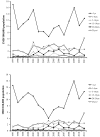The changing epidemiology of meningococcal disease in Quebec, Canada, 1991-2011: potential implications of emergence of new strains
- PMID: 23209803
- PMCID: PMC3510192
- DOI: 10.1371/journal.pone.0050659
The changing epidemiology of meningococcal disease in Quebec, Canada, 1991-2011: potential implications of emergence of new strains
Abstract
Background: In order to inform meningococcal disease prevention strategies, we analysed the epidemiology of invasive meningococcal disease (IMD) in the province of Quebec, Canada, 10 years before and 10 years after the introduction of serogroup C conjugate vaccination.
Methodology: IMD cases reported to the provincial notifiable disease registry in 1991-2011 and isolates submitted for laboratory surveillance in 1997-2011 were analysed. Serogrouping, PCR testing and assignment of isolates to sequence types (ST) by using multilocus sequence typing (MLST) were performed.
Results: Yearly overall IMD incidence rates ranged from 2.2-2.3/100,000 in 1991-1992 to 0.49/100,000 in 1999-2000, increasing to 1.04/100,000 in 2011. Among the 945 IMD cases identified by laboratory surveillance in 1997-2011, 68%, 20%, 8%, and 3% were due to serogroups B, C, Y, and W135, respectively. Serogroup C IMD almost disappeared following the implementation of universal childhood immunization with monovalent C conjugate vaccines in 2002. Serogroup B has been responsible for 88% of all IMD cases and 61% of all IMD deaths over the last 3 years. The number and proportion of ST-269 clonal complex has been steadily increasing among the identified clonal complexes of serogroup B IMD since its first identification in 2003, representing 65% of serogroup B IMD in 2011. This clonal complex was first introduced in adolescent and young adults, then spread to other age groups.
Conclusion: Important changes in the epidemiology of IMD have been observed in Quebec during the last two decades. Serogroup C has been virtually eliminated. In recent years, most cases have been caused by the serogroup B ST-269 clonal complex. Although overall burden of IMD is low, the use of a vaccine with potential broad-spectrum coverage could further reduce the burden of disease. Acceptability, feasibility and cost-effectiveness studies coupled with ongoing clinical and molecular surveillance are necessary in guiding public policy decisions.
Conflict of interest statement
Figures



References
-
- Pollard AJ, Scheifele D, Rosenstein N (2001) Epidemiology of meningococcal disease in North America. Methods Mol Med 67: 341–356. - PubMed
-
- Ashton FE, Caugant DA (2001) The panmictic nature of Neisseria meningitidis serogroup B during a period of endemic disease in Canada. Can J Microbiol 47: 283–289. - PubMed
-
- Law DK, Stoltz J, Henderson AM, Tsang RS (2005) Antigenic and genetic characterization of serogroup C meningococci isolated from invasive meningococcal disease cases in Canada from 1999 to 2003. Can J Microbiol 51: 523–530. - PubMed
MeSH terms
LinkOut - more resources
Full Text Sources
Medical

